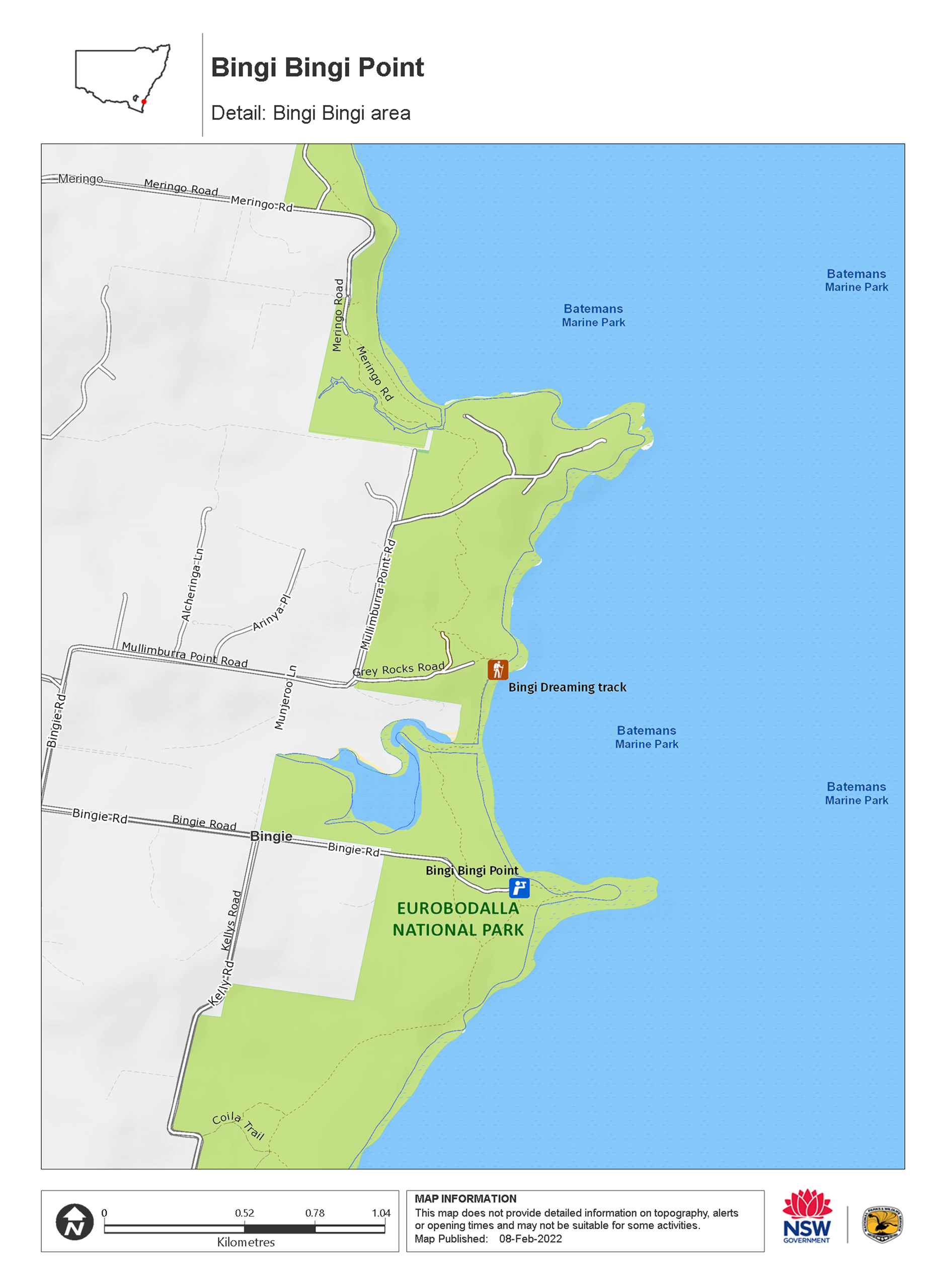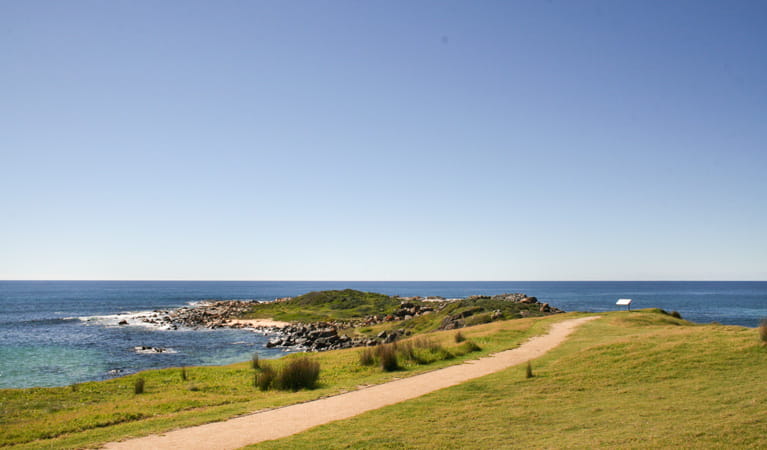Overview
Bingi Bingi Point is situated between Congo and Tuross and is a great place for scenic views, whale watching, surfing, walking and birdwatching within Eurobodalla National Park.
- Type
- Lookouts
- Where
- Eurobodalla National Park in South Coast
- Accessibility
- Medium
- What to
bring - Hat, sunscreen
- Please note
- Remember to take your binoculars if you want to go birdwatching or whale watching.
- The weather in the area can be extreme and unpredictable, so please ensure you’re well prepared for your visit.
Bingi Bingi Point offers a scenic expanse of golden beaches and untamed bushland with sea eagles soaring overhead and waves crashing on rugged rocks below. Perched on the edge of Eurobodalla National Park on the south coast, even if it’s not whale watching season, there are birdwatching opportunities all year round.
Bingi Dreaming track runs from Congo to Tuross and passes Bingi Bingi Point. Hike a section of this track, enjoy walking around the rocks, having a picnic or taking in the scenic coastal vista.
Keep your eyes peeled for the rusted remains of the ill-fated SS Monaro on the eastern end of the point. On the morning of 29 May 1879 the 521-tonne vessel ran ashore after battling bad weather and heavy seas, and within hours the ship was in pieces.
Map

Map legend

Local alerts
For the latest updates on fires, closures and other alerts in this area, see https://www.nationalparks.nsw.gov.au/things-to-do/lookouts/bingi-bingi-point/local-alerts
General enquiries
- National Parks Contact Centre
- 7am to 7pm daily
- 1300 072 757 (13000 PARKS) for the cost of a local call within Australia excluding mobiles
- parks.info@environment.nsw.gov.au
Park info
- in Eurobodalla National Park in the South Coast region
Eurobodalla National Park is always open but may have to close at times due to poor weather or fire danger.
Visitor info
All the practical information you need to know about Bingi Bingi Point.
Getting there and parking
Bingi Bingi Point is in Eurobodalla National Park. To get there:
- Turn off the Princes Highway at Bergalia, which is 8km south of Moruya.
- Follow the sealed road for approximately 4km until you reach a T-junction
- Turn right and follow the road for about 2km to Bingi Bingi Point
Road quality
- Unsealed roads
Vehicle access
- 2WD vehicles
Weather restrictions
- All weather
Parking
- Parking is available in sandy gravel carparks at the end of the road.
- It can be a busy place on the weekend, so parking might be limited.
Best times to visit
There are lots of great things waiting for you in Eurobodalla National Park. Here are some of the highlights.
Autumn
Head out for a spot of fishing – either from the beach or lakeside, on a boat or from a kayak.
Spring
A lovely time of year to walk all or a short part the Bingi Dreaming track – coastal banksias and a range of other wildflowers will be on display.
Summer
The perfect time of year for a family camping holiday by the beach – try Congo campground near Moruya or Beachcomber Holiday Park near Bodalla.
Winter
Head to Mystery Bay for a picnic and spot of whale watching. be sure to take your binoculars for a close up view.
Weather, temperature and rainfall
Summer temperature
Average
18°C and 23°C
Winter temperature
Average
6°C and 17°C
Rainfall
Wettest month
March
Driest month
July
Facilities
Carpark
Seats and resting points
There are 2 bench seats on the southern track that leads out onto the headland.
Maps and downloads
Accessibility
Disability access level - medium
There are parts of Bingi Bingi Point where assistance may be required:
- The area is mostly flat, but there are 25 steps leading down from the carpark to the beach.
- There are tracks that go from the carpark further out onto the headland. They are hard-packed ground mixed with grass and uneven.
There are 2 bench seats where you can rest in the southern part of the track that loops around the headland.
Prohibited
Pets
Pets and domestic animals (other than certified assistance animals) are not permitted. Find out which regional parks allow dog walking and see the pets in parks policy for more information.
Smoking
NSW national parks are no smoking areas.
Learn more
Bingi Bingi Point is in Eurobodalla National Park. Here are just some of the reasons why this park is special:
Aboriginal cultural heritage

Eurobodalla National Park is the traditional Country of the Yuin People. The park's landscape provided a rich source of food, shelter, medicines and weapons and continues to be an important place for Aboriginal people today. Walk the Bingi Dreaming track to follow the footsteps of the Brinja-Yuin People. Dreaming tracks traditionally linked the places visited by local Aboriginal people, then extended to connect other places utilised by neighbouring clans so that all Aboriginal people in Australia were connected by these unique highways.
- Aboriginal culture tours at Eurobodalla Follow Aboriginal Dreaming tracks in Eurobodalla National Park on a guided tour with Minga Aboriginal Cultural Services. Take part in cultural activities and share in the local knowledge of the Yuin People.
- Bingi Dreaming track Head out for a day walk on the Bingi Dreaming track, a coastal walk that traces the ancient Song Lines of the Yuin Aboriginal people. Enjoy stunning views as you walk.
- Guided Aboriginal culture walk with a Yuin Elder Trace the footsteps of the Yuin People along Bingi Dreaming track in Eurobodalla National Park with Southbound Escapes. Hear Dreamtime stories and learn about Aboriginal culture on this 2-hour walking tour.
- Traditional weaving workshop: Eurobodalla Get creative on a traditional weaving workshop in Eurobodalla National Park, between Bermagui and Narooma. Learn Aboriginal weaving techniques and see how these ancient skills carry a strong connection to Aboriginal culture.
Birds galore

Eurobodalla National Park provides an important habitat for a wide variety of birds, with 131 bird species having been recorded in the park. Estuaries and headlands within the park are important over-wintering areas for migratory birds, including 17 species of waders. In the summer, you may be lucky enough to see little terns nesting on the ground on sand islands, sandspits and dunes. If you do, please take care not to disturb this precious bird. You may also catch a glimpse of a sooty owl roosting in eucalypt forests in deep moist gullies, or the hooded plover which was only recently recorded in the park with potential threats similar to those of the little tern.
- Bingi Dreaming track Head out for a day walk on the Bingi Dreaming track, a coastal walk that traces the ancient Song Lines of the Yuin Aboriginal people. Enjoy stunning views as you walk.
Historic heritage

The period from the 1840's to the 1900's saw a rapid development of the area as a result of several often short-lived gold rushes, the growth of more intensive pastoral and agricultural land uses, and the expansion of timber getting activities. Many small towns grew up throughout the area, often acting as transport hubs and points of supply for surrounding districts. South Head at Moruya has many reminders of the important role shipping played, including several breakwaters and training walls that guided shipping through the river mouth, as well as the pilot's cottage and several smaller buildings situated on the headland.
Water abounds

Eurobodalla National Park contains a range of aquatic environments, including lagoons, lakes, estuaries, sheltered and wild beaches that protect a wide variety of plants and animals. For visitors, these aquatic environments offer a huge range of water-based activities, like waterskiing and boating at Corunna Lake, fishing and swimming around Mullimburra Point, surfing at 1080 Beach and paddling on Brou Lake and around Lake Tuross. It's the perfect place to visit during the summer holidays.
Plants and animals protected in this park
Animals
-

White-bellied sea eagle (Haliaeetus leucogaster)
White-bellied sea eagles can be easily identified by their white tail and dark grey wings. These raptors are often spotted cruising the coastal breezes throughout Australia, and make for some scenic bird watching. Powerful Australian birds of prey, they are known to mate for life, and return each year to the same nest to breed.
-

Australian pelican (Pelecanus conspicillatus)
The curious pelican is Australia’s largest flying bird and has the longest bill of any bird in the world. These Australian birds are found throughout Australian waterways and the pelican uses its throat pouch to trawl for fish. Pelicans breed all year round, congregating in large colonies on secluded beaches and islands.
-

Humpback whale (Megaptera novaeangliae)
The humpback whale has the longest migratory path of any mammal, travelling over 5000km from its summer feeding grounds in Antarctica to its breeding grounds in the subtropics. Its playful antics, such as body-rolling, breaching and pectoral slapping, are a spectacular sight for whale watchers in NSW national parks.
-

Yellow-tailed black cockatoo (Calyptorhynchus funereus)
The yellow-tailed black cockatoo is one of the largest species of parrot. With dusty-black plumage, they have a yellow tail and cheek patch. They’re easily spotted while bird watching, as they feed on seeds in native forests and pine plantations.
-

Peron's tree frog (Litoria peroni)
Peron’s tree frog is found right across NSW. These tree-climbing and ground-dwelling Australian animals can quickly change colour, ranging from pale green-grey by day, to a reddish brown with emerald green flecks at night. The male frog has a drill-like call, which has been described as a 'maniacal cackle’.

